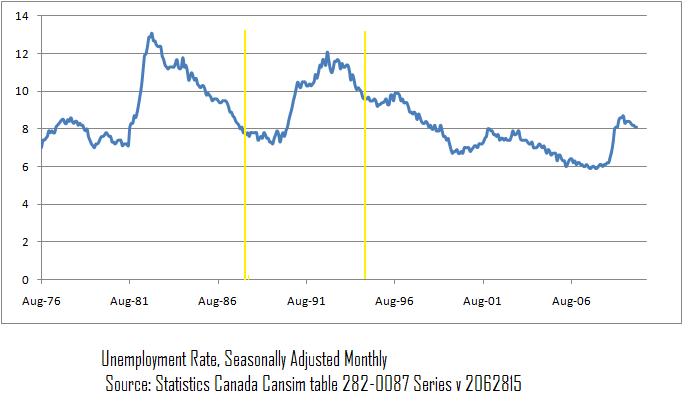[Previous entry: "Fiscal Policy - Hands on? Hands off?"] [Next entry: "US housing prices fall. Why do we care?"]
11/21/2010: "To Trade or Not to Trade ...That is the Question"
In 1988 Canada signed a free-trade agreement with the United States. In 1994, the North American Free Trade Agreement (NAFTA) allowed for free trade between Canada, the United States and Mexico came into effect. In both cases people across Canada were worried about the detrimental effects of free trade on employment and production in Canada.
The above graph shows the unemployment rate in Canada from 1976 to 2010 and the two yellow bars indicate the implementation of the two free trade agreements. The increase in unemployment in the late 1980s was due to the monetary contraction which was designed to fight inflation, not due to the free-trade agreement. The evidence on the unemployment rate does not seem to support the claim that free-trade causes unemployment. Most economists would agree that free trade is generally good for the economy, and this is the position taken by the textbook.
So why do people still oppose free trade? An October 27th article in the Globe and Mail claims that a free-trade agreement with the European Union would cost the economy a minimum of 28,000 jobs. If predictions of a continued appreciation of the Canadian dollar come to fruition, a total of 152,000 jobs will be lost. (Click here for article 1). Using the example in the text, imagine that Jacqueline and Samantha are actually two different countries. When Samantha starts specializing in wood chopping, jobs would be lost in the bread making industry. And when Jacqueline specializes in bread making, jobs would be lost in the wood chopping industry. There is no doubt that jobs will be lost in industries where Canada has a comparative disadvantage. What the article does not say is that jobs will be created in industries where Canada has a comparative advantage.
Canada has the second lowest population density in the world. That would tend to suggest that we are at a comparative disadvantage on anything that is labour intensive. Food processing and apparel making are two examples of industries that are typically labour intensive.
If the Canadian dollar continues to rise, exports would fall, imports would rise and jobs would be lost. However, the Canadian dollar is rising against the US dollar, not the euro or British pound. The jobs lost would be independent of any trade deal with Europe.
A second article, also from the Globe and Mail dated October 25th is even more troubling. This article deals with interprovincial trade barriers. (Click here for article 2) At issue in this article are butter-like spreads that are a combination of a bit of butter with vegetable or soy oils. These products are lower in trans-fats and saturated fats, making them healthier. Unfortunately, it is illegal to sell them in Ontario and Quebec. If the arguments in favour of free trade based on comparative advantage are true at the international level, they should also be true at the interprovincial level.
Barriers to trade increase prices to consumers, whether they are international, or interprovincial. Those parties that argue against free trade are usually those that will be directly affected. In the first article, the study was done by an economist working for the Canadian Auto Workers, the union that represents the workers in those industries that will be directly affected by the EU deal. In the second article, the dairy regulations are intended to protect dairy farmers in Ontario and Quebec at the expense of canola farmers in the Prairie Provinces.
Relevant Learning Objectives
Appendix A
LO#3 Describe how comparative advantage, specialization and trade make us all better off.
Chapter 9
LO#1 Describe how comparative advantage, specialization, and trade can improve living standards.
LO#2 Explain how competition creates winners, losers, and opponents to trade and analyze three forms of protectionism.
Sources
1 Free-trade deal with EU could cost thousands of Canadian factory jobs, Greg Keenan, Globe and Mail October 7, 2010 accessed November 2, 2010
2 Alberta wins dairy trade ruling, Barrie McKenna, Globe and Mail October 25, 2010 accessed November 2, 2010
Questions
1. Looking at the two tables at the bottom of article 1 in what industry or industries do you think Canada has a comparative advantage?
2. Looking at the two tables at the bottom of article 1 why do you think it Canada both imports and exports turbo-jets, turbo propellers and other gas turbines?
3. Canada has the second largest known reserves of oil in the world, second only to Saudi Arabia. Why would Canada import crude petroleum from Europe?
4. What argument could be used in favour of the ban on butter-like products in Ontario and Québec that contain less than 50% carry products?
Michael S. Leonard
Kwantlen Polytechnic University
Surrey, BC

